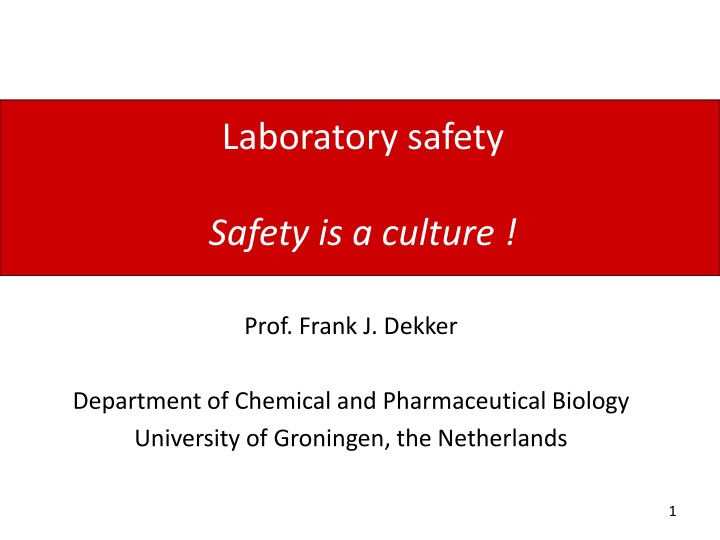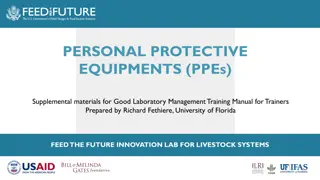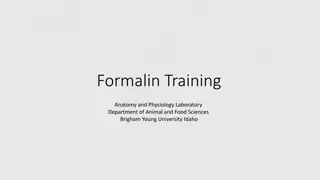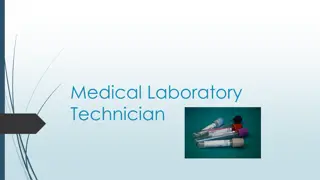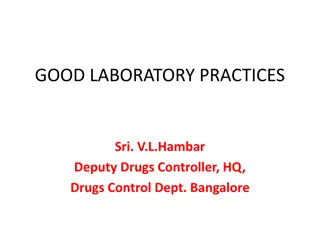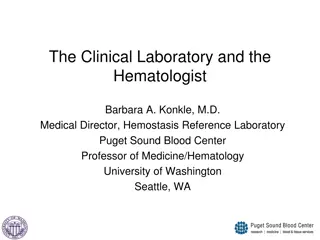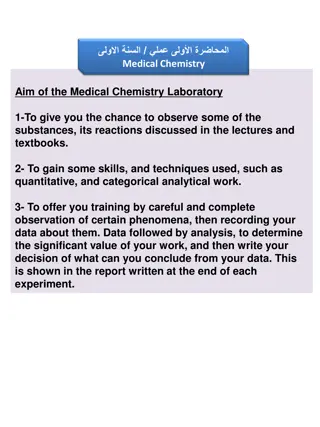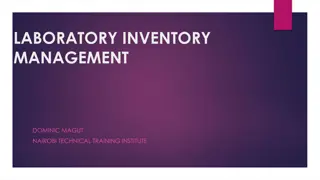Laboratory Safety Guidelines for Research Professionals
Safety in the laboratory is a fundamental aspect that requires a culture of responsibility and awareness. This comprehensive guide by Prof. Frank J. Dekker covers general safety principles, the importance of protective clothing, and what to do in case of accidents. Emphasizing the significance of awareness, organization, and prompt action, these guidelines aim to create a safe working environment for all laboratory personnel.
Download Presentation

Please find below an Image/Link to download the presentation.
The content on the website is provided AS IS for your information and personal use only. It may not be sold, licensed, or shared on other websites without obtaining consent from the author.If you encounter any issues during the download, it is possible that the publisher has removed the file from their server.
You are allowed to download the files provided on this website for personal or commercial use, subject to the condition that they are used lawfully. All files are the property of their respective owners.
The content on the website is provided AS IS for your information and personal use only. It may not be sold, licensed, or shared on other websites without obtaining consent from the author.
E N D
Presentation Transcript
Laboratory safety Safety is a culture ! Prof. Frank J. Dekker Department of Chemical and Pharmaceutical Biology University of Groningen, the Netherlands 1
General principles Working safely is your own responsibility. Inform yourself on the safety risks of specific procedures. https://s-media-cache-ak0.pinimg.com/564x/36/98/58/36985891025b59166079880642593e02.jpg If you feel uncertain ask help from experienced lab members. Keep the working space clean and organized. Work with a well-organized lab journal and register your files. Never work in a hurry. Keep notice of your colleagues in the lab. Know where the emergency exit and fire extinguishers are. 2
General principles Lock the doors if you leave. If you are working all doors should be open (emergency exit). Never work alone. If you are working outside working hours inform the safety department by phone 5520 (this is for rescue activities) or register via the website outside working hours call! 5520 http://myuniversity.rug.nl/infonet/medewerkers/fwn/arbomilieuveiligheid/ Under building safety -> FWN presence 3
Biology protective clothes https://s-media-cache-ak0.pinimg.com/564x/ef/24/1a/ef241a134991ac1f0c5e50b9fdcebecf.jpg In the biology lab always wear a lab coat. The lab coats should not leave the lab. Wear gloves if you handle dangerous chemicals. Wear gloves to avoid contamination in the flow hood. Do not carry gloves in non-contaminated environment (eg. the corridor). http://www.phdcomics.com/comics/archive/phd082710s.gif 4
Accident In case of an accident Don t try to hide the accident Call for help of your collegues Call the emergency number (3045 in day and 8050 at night) In case of bleading use the emergency kit In case of fire; rescue yourself and collegues and try to confine the fire In case of spills; use the chemical absorber Report the accident via one of the technicians to the Arbo&milieu department 5
Protective clothes In the chemistry lab always wear glasses and a labcoat. In the biology lab always wear a labcoat. The labcoats should not leave the lab. Wear gloves if you handle dangerous chemicals. Wear gloves to avoid contamination in the flow hood. Do not carry gloves in non-contaminated environment (eg. the corridor). Wear long trousers/skirt and stirdy shoes (if not cover them by a long labcoat). Tie up you hair if you work with rotating part, dangerous chemicals or a flame. 6
Handling glassware Never use broken glassware. Remove broken glassware immediately. If you connect tubes to glassware be aware of breaking/cutting danger. To avoid this wrap the part you handle with a sturdy towel. Never put big forces on glass because it will break. Never put pressure on glass because it could explode violently. If you put pressure (column, nitrogen) always leave a way out to avoid overpressure. If you handle reaction with develop pressure, leave the vessel open. 7
Handling glassware If you handle reactions that release gas leave the vessel open and run the reaction slowly (dropwise/portionwise addtion of the reagents) and cool the reaction if possible. Dangerous reagents: NaH as a base (release of H2) H2O2 as an oxidant (release of H2) Quenching BH3 with H2O2 (violent releas of H2) Deprotections of carbamates (Boc-NH etc) Mixed anhydride coupling (ethylchloroformate, Et3N) BuLi as a base (relase of H2 and ignition of the solvent) Drying solvents with Sodium as a metal. 8
Handling glassware Always carry reagens is a specially disignated bucket or rack. Carry bottles of reagents with two hands for transport. Never carry of bottle with the cap. Remind that you are in very deep trouble if you drop a bottle Methyliodide (CH3I), ethylchloroformate etc. If you drop a bottle immediately drop the chemical absorber (under the sink in the chemistry lab) and if not possible immediately then evacuate everyone and call the emergency number (3054 day and 8050 night). 9
Disposal of chemicals Never discard chemicals in their most reactive form. They should be neutralized but be aware of the risk of violent reactions: Dilute strong acids by slow addition of the acid to a cooled bath of water (H2SO4). Neutralize strong bases (Na, BuLi, NaH) by slow addition is isopropanol and cooling. Hydrogen gas (H2) will evolve. The the H2 evolution stops let is stand for a sufficient amount of time (several hours) to allow complete reaction. Then start slow dilution with water watch potential evolution of of H2 gas and wait long enough. Then the mixture can be disposed. Neutralize oxidizing such as H2O2 with meta-bisulphite (Hydrogen peroxide may be decomposed by adding sodium metabisulfite or sodium sulfite after diluting to about 5%. Dispose according to methods outlined for waste disposal). CN- containing solution (NaBH3CN). Always keep them basic! HCN is a very toxic gass! 10
General principles Never leave an unsafe situation non-supervised Never work completely alone in the laboratory. Some should be able to provide help 11
Biology working with GGOs GGO s should not leave the laboratory. The labcoat should not leave the laboratory. Wash your hands before leaving the lab. Destroy GGO s immediately if no longer needed. Store GGO s according to the rules (-80 oC book). If the GGO scan t be traced the lab can be closed by Arbo&Milieu! https://s3.amazonaws.com/lowres.cartoonstock.com/food-drink-corn-gmos-genetic-genetically_modified_foods-mutations-aprn91_low.jpg 12
Biology waste disposal Dispose you waste in the right can. Glass not in autoclave bags (clean/sterilize and put in the black bin). Biologically contaminated waste in autoclave bag. Chemically contaminated waste in the black bin. Clean plastic in the plastic box, clean glass in the glass box. Bring empty boxes and other large waste directly to the elevator. Use a double autoclave bag and close the separately. http://djx5h8pabpett.cloudfront.net/wp-content/uploads/sites/2/2015/09/No-jokes.jpg 13
Biology cell culture In the cell culture the same rules apply for waste disposal. Clean everything with hypochlorite solution before discarding. Test your cells regularly on mycoplasma infections. https://s3.amazonaws.com/lowres.cartoonstock.com/science-stem_cell_research-science-debates-stem_cell-cellphone-mban1172_low.jpg Clean the flow hood before and after use with 70% ethanol. Work with gloves in the flow hood! Clean pipettes and everything else that goes in with 70% ethanol. 14
Biology general labrules Refill containers vials and stores if they are empty. https://s-media-cache-ak0.pinimg.com/736x/b6/5c/2e/b65c2e9956b2556b5c322538ed2bae56.jpg If something runs out tell Petra! If something is dirty clean it immediately. Don t leave reagents on your desk. Don t exchange pipettes. Throw your old buffers. 15
Biology general labrules Label every vial with your name and a date. Non-labelled vials will be thrown away. http://cdn.shopify.com/s/files/1/0212/1004/products/lab-rules-2_large.jpeg?v=1428097973 For your name use a three letter code. One letter from you first name Two letters from your last name Leave you workspace empty after leaving. Do the labtaks assigned to you by the labmanager. 16
Summary 18
